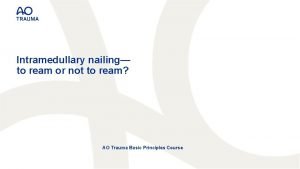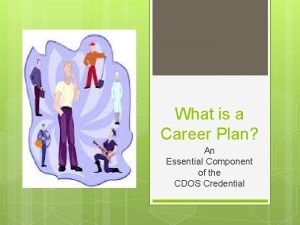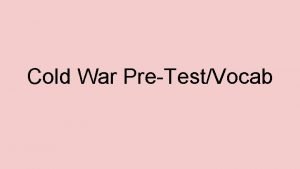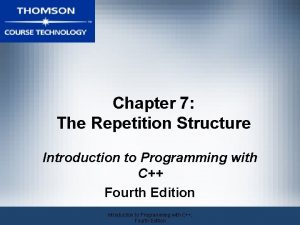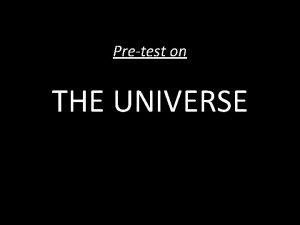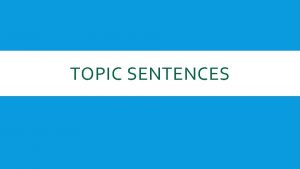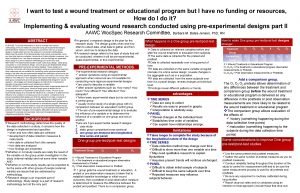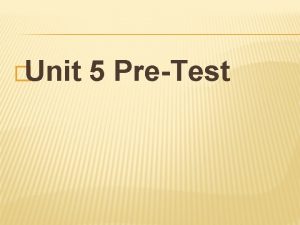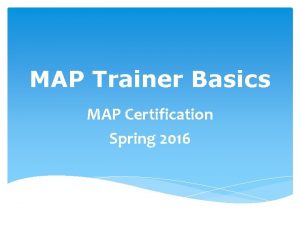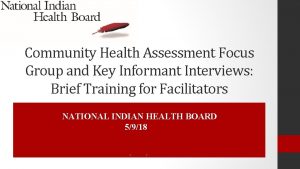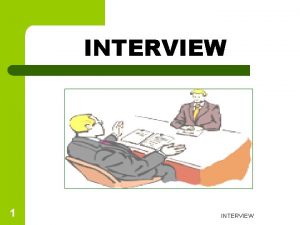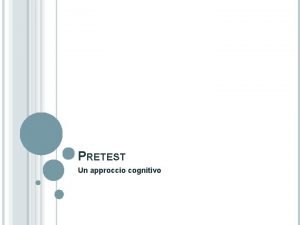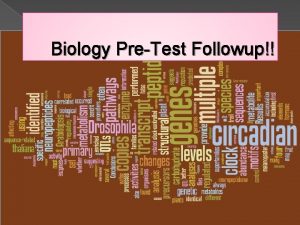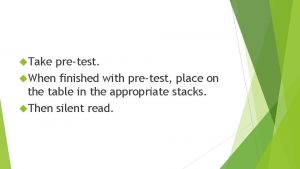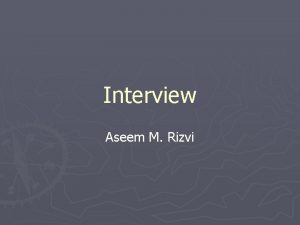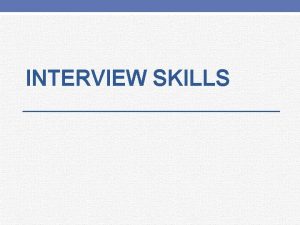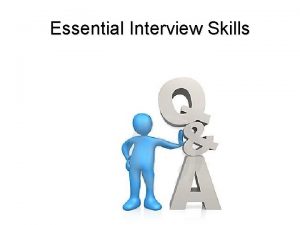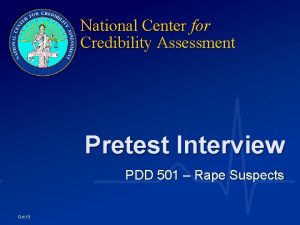Nailing the PreTest Interview Interview The key to












































- Slides: 44

Nailing the Pre-Test Interview: Interview The key to reducing no opinion tests Milton O. “Skip” Webb, Jr. Supervisory Special Agent, USA CID Chairman, Board of Directors, APA

Introduction The Army Method of Teaching n Tell’um what you’re going to tell’um Tell’um what you told’um Test’um on what you told’um n NO TEST TODAY! n n n

How Often Have You Said…. . . n He’s almost passing the test… I think I can pull him through. n n Pre-disposing results 1 st chart assumptions swaying the results He’s DI. I can tell already n n Subjective opinions Failure to provide an unbiased test

How Often Have You Said…. . . n He’s no opinion…but I can tell he isn’t the guy who did it. n n n “Calling” inconclusive charts Misleading the investigation I don’t like this guy’s looks. n Personal Bias

How Often Have You Said…. . . n What the hell is this guy’s problem. . He’s inconclusive. n n Blaming the examinee This guys hitting everything on the chart. Failing to see the obvious n Failing to realize the problem may be you! n

Today’s Plan of Attack n Recognize what causes no opinion tests Before the test n The pre-test itself n n n Realize that our pre-test is the #1 cause Discuss the problems that cause no opinion results Evaluate what we can do to increase test accuracy and utility. Review our plan and make the changes!

The Defense Attorney’s Prayer “God save me from an innocent client” n n n the polygraph examiner, whether in private practice or in law enforcement, secretly shares the same fear as the defense attorney. Have we done our job well enough to protect an innocent examinee? Any examiner, regardless of competence, can run a “DI” test. If we are “pretty good”, we can run an inconclusive test. Only the best have the skill and dedication to run an NDI test.

People Are Not Inconclusive or “no opinion”. Polygraph Charts sometimes are n n n Your examinee knows the truthful answer to all of the questions on the test If he elects to lie on the test, he does so consciously and intentionally. One can not lie accidentally! If your test fails to detect the truth…. . Either the test didn’t work properly n OR YOU DIDN’T WORK PROPERLY n

Analyzing The Problem The things we don’t want to hear! n n n Most no opinion polygraph tests result primarily from examiner failures. No opinion polygraph tests can usually be traced to one or more mistakes or poor decisions on the part of the examiner. A properly conducted, valid polygraph test using sound facts and proper techniques is extremely robust and seldom results in a no opinion result.

We Must Realize that…. . n Polygraph has Limits! n Polygraph is robust but not a universal tool n Some things don’t lend themselves to polygraph n Testing Intent – “Shoplifting the watch” n Testing what someone else did “Was she unconscious? ” – “Was she drunk? ” n Polygraph is not a replacement for investigation n Polygraph should be used AFTER the investigation not INSTEAD of the investigation n Polygraph is NOT a “Swiss Army Knife” or a jewelers tool…it’s a sledge hammer!

Before The Test Starts…. . n Insufficient knowledge of the case facts n If your examinee is DI then he already knows more about the case than you do! n n n Your lack of knowledge will give the DI examinee confidence = no opinion If your examinee is NDI he needs you to know all of the case facts! n n Your lack of knowledge will cause the NDI examinee to lose confidence in the polygraph & you NDI examinee loss of confidence = no opinion

Before The Test Starts…. . n Insufficient knowledge of the case facts result from…. . Failure to fully review the case file n Failure to ask the right questions n of investigators n of the examinee during pre-test interview n Laziness, lack of time n Making Assumptions instead of getting facts n Assuming facts not in evidence n Mind reading n

Before We Start (Cont’d) n Failure to Allow Time for the Test You can’t run a conclusive 1 st test of the day, thinking about the 2 d one or the 3 d one. n You owe the examinee your full attention n If you’re rushing through the pre-test, you’re rushing towards another series! n You are not helping the department or your client by trying to do too much too quick n n Over Scheduling & lack of Flexibility n Don’t lock yourself or the examinee in too tight

Before We Start (Cont’d) n Know the Examinee’s schedule Does he have another appointment? n Does something else have his attention? n Is his mind on the job at hand? “DRIFT” n n How about Your Schedule? Do you have another appointment? n Does something else have your attention? n Is your mind on the job at hand? n

Before We Start (Cont’d) n Your Appearance: Professionally dressed or dressed for golf? n Professionally groomed or looking like a bum? n n Your Polygraph Suite: Do you have “I love me walls” ? n Is your suite the “National Repository of Stuff”? n Do you have the examinee facing a mosaic wall or mind numbing pattern? n

Conclusions n n n No Opinion Results Can sometimes be avoided before the test ever begins! Sometimes we screw up the test before we ever meet the examinee! Prior n Planning n Prevents n Poor n Performance

The Initial Meeting n Starts with the introduction n n Firm but friendly handshake and a smile Initial pleasantries & icebreaking n n n n Don’t rush right into pre-test Get the examinee started in “the talking mode” Ask open ended questions Allow time for examinee to adjust to you and the room Try to find some common conversational grounds Provide an overview explanation of the entire process from start to finish Cover the need for any required paperwork

Beginning the Pre-Test Phase n The #1 reason we have no opinion results – Poor Pre -test interview n n Too short…Boring to you – meaningless to examinee Failure to take the time to……. n Develop comparison material during the interview n Explain the instrument n Explain the physiology n Explain what happens when we lie n Discuss the case facts in detail n Explain what the relevant questions mean to you –to him n Explain the need for the comparison questions

Develop Comparison Material During Collection of Background Information n We must have a background interview to develop comparison material & lock the examinee into the probable lie. We must explain in general, non accusatory terms the traits that make a thief, a liar, a sex pervert, an arsonist…. We must have examinee commit to these traits and deny having them!

Explain the Instrument n Explain the components and what they do. Show them to the examinee n Explain where they go on the body n Explain what data they collect n Explain how they collect the data n Explain why that data is important n n Begin to tie components to the physiology we monitor & the relationship to F 3

Explain the physiology n n n This is not merely a science lesson! We must explain F 3 to make it work well We must give visual and mental examples We must tie it to something they may have experienced before We must describe the “feelings” We must differentiate F 3 from nervousness and anxiety n Using “The lake”

Explain What Happens When We Lie n n Tying the physiology and F 3 to lying Provide vivid physical examples “Hair on the back of our neck” n “Skin Crawling” n “Heart in my stomach” n “Cold Chills” n “Goose bumps” n White as a ghost…”chalky”…. Pale…gray n n Show an example if you like…. .


Discuss the case facts in detail n Let the examinee explain what he knows about the case. Let him do the talking initially. Clear up emotional baggage n Get rid of anger & confusion n n Encourage him to explain his side of the story. (May be the 1 st time) Clear up errors, misinformation about issues Settle on agreed upon case facts

Explain What the Relevant Questions Mean n Don’t assume your understanding of the relevant questions is his understanding. Use “Tell me what that means to you” Make sure he understands wording and terminology n Keep the relevant questions Direct n Simple n Physical n

Explain the Comparison Questions n n n The comparison questions must be meaningful and appear relevant to the issue under investigation. The need must be presented so as to create a real concern to the examinee’s success or failure. They should be presented as RELEVANT ISSUES to the investigation and have consequences. You should have locked him in back during the background interview. Develop a sound and viable reason to ask these questions.

How the Comparison Question is used? n For the innocent examinee: 1. 2. 3. 4. n A focal point for innocent anxiety A lightning rod for innocent concern A new found problem for the NDI person Stimulation to the bored innocent examinee For the guilty examinee: n Nothing…Absolutely Nothing!

Questions About Questions? ? n n n Must the Examinee have actually committed the comparison infraction? - - No Should the infraction be one that the examinee could have committed? - - Yes Should the infraction be something the examinee has thought about before? - - Not necessarily n Should the infraction relate to the relevant issue? Under investigation - -Absolutely!

Selecting the Proper Comparison Question Matching the comparison questions to the crime n Should be same type offense n. Larceny – Theft, Fraud, Shoplifting, Forgery n. Assault – Hurt, Harm or Injure n. Damage – Damage n. Sex – Sex, Sex lies, Sexual Fantasy n Should be easily incorporated into pre-test n. Should not be more heinous than the offense n. Can be “Thought” comparisons n. Lie Comparisons are not good for every test !

Effective Introduction of Comparison Questions n Creating Question Importance to the Test n Questions should not appear to be any different than the relevant issue Stealing from a sibling? ? ? n Stealing from mom’s purse? ? ? n n Establish the Need For these “Other” Questions n n Integral part of testing procedure I’m not willing to vouch for you unless I’m satisfied you’re not that kind of person.

Effective Introduction of Comparison Questions (Cont’d) n Making the Questions Meaningful to the Process Four Types of Thieves – Larceny, Fraud n Profile of an Offender – Sex, Damage, Injury n Critical Integrity – Lies n Psychology of Offender – anything else n n Questions Must Appear to be a Logical Part of the Test

Setting up the Theft Comparison Question n n n Should start during the gathering of background information. Must be a normal conversational progression. Introduction must make sense to the examinee Discussion should appear to be part of overall questioning about the offense. Work history, Family history & School history Determine prior contact with police

Setting up the Theft Comparison Question (Cont’d) n n My job is to narrow down the number of suspects to one or two. Police can then fully concentrate on less suspects. n n n Surveillance Credit checks Family members Neighbors Supervisors Friends We know the type of person who commits thefts 4 Types of thieves I don’t believe thieves ever change n n Risk & reward Background investigation only detects the dumb thief

Setting up the Sex Comparison Question (Cont’d) My job is to determine if you fit the profile of a sexual offender. They are sexually abnormal people. l Police will then concentrate on this type suspect. l – Surveillance Co-workers – Family members Neighbors Supervisors Friends We know the type who does this - profile l Abnormal/aberrant sexual conduct is progressive l Starts out personal – masturbation, porno, peeping l Poor sexual maturity – uncomfortable with women l Progressive – unnatural sex, forced intentions, l Ultimately leads to criminal sexual acts. l

Setting up the Lie Comparison Question My job is to assure the police that you can be trusted. l Police can then fully concentrate on less suspects. l – School Records Co-workers – Family members Neighbors Supervisors Friends We know the type who does this - profile l Lying is a learned process that has proven to be effective and successful to the liar in the past. l People who avoid responsibility for actions l Lack of social maturity l Unable or unwilling to correct behavior l They do it because it has worked for them. l

Effective Introduction of Comparison Questions (Cont’d) n Providing Value for the Comparison Questions to the Test Result n n Must answer all questions truthfully to pass the test Failure on any of these questions will place you IN THE SUSPECT POOL What is the most important question on this test? This is not an academic test! n n Failure of any question is failure of test 90% is not an “A” More like crossing the road or swimming You’ve got to successfully complete the entire test

Dealing with Admissions n Never accept behavior as normal. n n n n Always ask if examine learned from event. Always write down something on clipboard. Was this was repeated behavior? Do family, friends, co-workers, boss know? Did examinee list it on job applications? My report will become a permanent/public record Give some serious thought to ruling out this one, single aberrant act that examinee learned from. n n If this was the only time, you don’t want it effecting the test. If this was only infraction, I won’t report it.

Dealing with Refusals to Answer Comparison Questions n n n If examinee is to be ruled out. Must ask these questions DA, Police, Supervisor will not accept less No different from medical tests n Doctor takes temperature for ear infection n Doctor looks down throat for ear infection n Doesn’t just look in ear and clear patient as well Not willing to vouch for examinee without assessing these areas Unwillingness indicates there might be a problem That makes you stay in suspect pool. Using “Do You Remember” – The elephant

Counter-Countermeasures for use with Comparison Questions n Try to avoid the obvious exclusions “Before this year” n “Prior to this year” n “Between your 12 and 21 st birthday” n n Use More “meaningful” exclusions “While working at your previous jobs” n “Prior to your present employment” n “Before moving to your present address” n “While working at any of your previous jobs” n

The Acquaintance Test n Must explain the need for the test An opportunity for the examinee to become comfortable with the chair and components n An opportunity for you to “calibrate” the instrument to his physiology n An opportunity for him to become accustomed to sitting still and answering questions. n An opportunity for him to become comfortable with the testing process and your voice n NOT ABOUT SEEING WHAT IT LOOKS LIKE WHEN YOU LIE……… n

Pre-Test 1. Introduction & getting to know the examinee n 2. Background information n 3. n 6. Showing the components Physiology – what happens when we lie? n 5. Learning about the family Pick up names and important people Comparison Question Ground work Instrument explanation n 4. Forms completion and medical evaluation. Visual examples – common expressions of F 3 Screen shot Case Facts –Let the examinee talk Question review n n 100% to pass Comparison Question lock in time Not an academic test Most important question?

SUMMARY n n n Most no opinion polygraph tests result from examiner failures. A properly conducted, valid polygraph test using sound facts and proper techniques is extremely robust and seldom results in a no opinion result. Polygraph is NOT a “Swiss Army Knife” or a jewelers tool…it’s a sledge hammer!

Scenario n Between March 4 th and 7 th, 2005, a notebook computer valued at $2, 000. was stolen from the maintenance office of the 35 th Mess Kit Repair Facility, Camp Swampy, GA. PVT Weinstein was on extra duty during the weekend in question and was responsible for cleaning the maintenance office. The computer was last seen on Friday at the close of business and discovered missing on Monday Morning upon opening the office. There were no signs of forced entry into the office. PVT Weinstein has denied any involvement in theft of the computer and has agreed to examination by polygraph.

Facts About the Private n n n n He grew up in a small mid west town. High School graduate w/1 yr Community college He worked at several fast food restaurants prior to joining the Army. No prior trouble with the law. No prior disciplinary problems in the Army. Has older brothers and sisters. Identified by unit members as a computer guru.
 Reamed and unreamed nail
Reamed and unreamed nail Key partners example business model canvas
Key partners example business model canvas Business model canvas tripadvisor
Business model canvas tripadvisor Pretest: developing an academic and career plan
Pretest: developing an academic and career plan Pretest the early and mid-nineteenth century romanticism
Pretest the early and mid-nineteenth century romanticism Intravenous medication administration pretest
Intravenous medication administration pretest Intravenous medication administration pretest
Intravenous medication administration pretest Pretest growth development and sexuality
Pretest growth development and sexuality Pretest publicitario
Pretest publicitario Pretest communism and the cold war
Pretest communism and the cold war Proxy pretest design
Proxy pretest design Pepp pretest
Pepp pretest Proxy pretest design
Proxy pretest design Repetition structure in c++
Repetition structure in c++ Pretest: art in the 20th century and today
Pretest: art in the 20th century and today Pretest: the universe
Pretest: the universe Whats a pretest
Whats a pretest Parts of speech fill in the blanks
Parts of speech fill in the blanks Alejandro rodriguez vilela
Alejandro rodriguez vilela Wound care pretest
Wound care pretest Zero slop
Zero slop Www.hdmaster.com map
Www.hdmaster.com map Whats a focus group
Whats a focus group Hình ảnh bộ gõ cơ thể búng tay
Hình ảnh bộ gõ cơ thể búng tay Bổ thể
Bổ thể Tỉ lệ cơ thể trẻ em
Tỉ lệ cơ thể trẻ em Chó sói
Chó sói Tư thế worm breton là gì
Tư thế worm breton là gì Chúa sống lại
Chúa sống lại Các môn thể thao bắt đầu bằng tiếng chạy
Các môn thể thao bắt đầu bằng tiếng chạy Thế nào là hệ số cao nhất
Thế nào là hệ số cao nhất Các châu lục và đại dương trên thế giới
Các châu lục và đại dương trên thế giới Cong thức tính động năng
Cong thức tính động năng Trời xanh đây là của chúng ta thể thơ
Trời xanh đây là của chúng ta thể thơ Mật thư tọa độ 5x5
Mật thư tọa độ 5x5 101012 bằng
101012 bằng độ dài liên kết
độ dài liên kết Các châu lục và đại dương trên thế giới
Các châu lục và đại dương trên thế giới Thơ thất ngôn tứ tuyệt đường luật
Thơ thất ngôn tứ tuyệt đường luật Quá trình desamine hóa có thể tạo ra
Quá trình desamine hóa có thể tạo ra Một số thể thơ truyền thống
Một số thể thơ truyền thống Cái miệng nó xinh thế
Cái miệng nó xinh thế Vẽ hình chiếu vuông góc của vật thể sau
Vẽ hình chiếu vuông góc của vật thể sau Nguyên nhân của sự mỏi cơ sinh 8
Nguyên nhân của sự mỏi cơ sinh 8
